Outcome Driven vs. KPI/Metrics Driven: Why the Difference Matters
We measure what matters—but do we always achieve what we intended?
Most companies live and die by their KPIs. They track sales growth, customer satisfaction, time to resolution, or project delivery milestones. KPIs/metrics provide clarity, but clarity isn’t the same as progress.
Being metrics-driven means you’re chasing the numbers. Being outcome-driven means you’re asking a deeper question: Did those numbers actually move the business forward in a meaningful way?
The Trap of Metrics-Driven Leadership
Metrics are easy to capture, chart, and present in quarterly reviews. But metrics can mislead.
A 95% customer service SLA—yet churn is rising because customers still feel unheard.
A 20% bump in sales volume—yet profit fell because margin collapsed under discounting, or because delivery costs spiked when capacity limits were strained.
Projects are completed—yet no new revenue or capacity emerged.
The danger is simple: metrics measure activity, not impact.
What Outcome-Driven Leadership Looks Like
Being outcome-driven means defining success as the real-world shift the organization needed, not just the numbers on a dashboard.
“On-time project delivery” → Did it create capacity, reduce risk, or enable growth?
“High SLA response rate” → Did it improve loyalty, referrals, or lifetime value?
“Increased deal volume” → Did it actually raise profitability and strengthen position?
“Increasing sales volume from a few customers” → Did it insulate the business, or does it leave the company more vulnerable if a top-tier customer walks away?
Outcomes force leaders to connect the dots between data, behavior, and business advancement.
Outcome Debt: The Silent Killer
When companies chase KPIs/metrics without connecting them to outcomes, they build up what I call Outcome Debt.
On paper, things look fine—charts are trending green, sales volumes grow, projects are completed—but underneath, the business is drifting further away from its real goals.
Outcome Debt shows up when:
Growth looks strong, but profitability is shrinking or flat.
Efficiency metrics improve, but customers still defect to competitors.
Engagement scores rise, but the best people quietly exit.
Revenue is growing, but cash flow is tightening.
Projects are completed, but no meaningful outcome is achieved.
Like financial debt, Outcome Debt compounds over time. The longer leaders mistake KPIs/metrics for outcomes, the more costly the correction becomes.
Why This Matters for Growth Companies
For growth-stage companies especially, the temptation is to chase KPIs/metrics because they’re visible, measurable, and easy to report. But KPIs without outcomes are like sailing with the compass but no destination—you’re moving, but you don’t know if you’re heading anywhere that matters.
Outcome-driven leadership closes the loop:
Define the change you want to see in the business.
Translate that into measurable indicators.
Review whether hitting those indicators delivered the actual shift.
Takeaway: Measure, But Don’t Stop There
KPIs/metrics matter—but they’re not the finish line. The real question is: Did the business actually advance?
If you’re only focusing on metrics, you’re already behind.
Companies that learn to lead from outcomes—not just KPIs/metrics—are the ones that build results that last.
